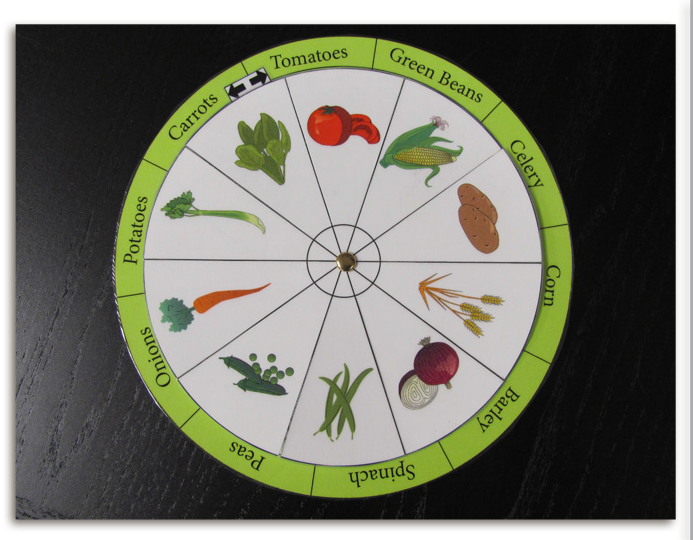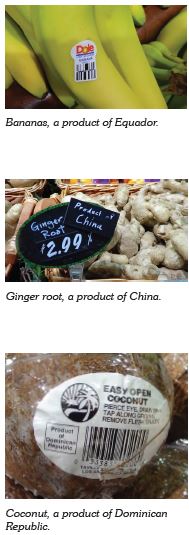Who Grew My Soup? (Grades K-2)
Students identify the source of the food they eat and investigate the processes and people involved in getting food from the farm to their spoon.
Background
Lesson Activities
Recommended Companion Resources
Credits
Author
Lynn Wallin | Utah Agriculture in the Classroom
Sources
- http://www.did-you-knows.com/did-you-know-facts/food.php?page=2
- http://www.frozenfoodfacts.org/about-frozen-foods/story-frozen-foods
- http://ezinearticles.com/?Soup-Facts---Fun-Trivia!&id=582906
- http://www.agfoundation.org/files/FFF_Graphic_US_Farm_Feeds.jpg
- https://www.ers.usda.gov/data-products/ag-and-food-statistics-charting-the-essentials/ag-and-food-sectors-and-the-economy/
Standards
Texas Content Area Standards
-
ELA: K.110.2.b.1
Developing and sustaining foundational language skills: listening, speaking, discussion, and thinking - - oral language. The student develops oral language through listening, speaking, and discussion.
- ELA: K.110.2.b.1.C: share information and ideas by speaking audibly and clearly using the conventions of language
- ELA: K.110.2.b.1.D: work collaboratively with others by following agreed-upon rules for discussion, including taking turns;
-
ELA: 1.110.3.b.1
Developing and sustaining foundational language skills: listening, speaking, discussion, and thinking - - oral language. The student develops oral language through listening, speaking, and discussion.
- ELA: 1.110.3.b.1.C: share information and ideas about the topic under discussion, speaking clearly at an appropriate pace and using the conventions of language
- ELA: 1.110.3.b.1.D: work collaboratively with others by following agreed-upon rules for discussion, including listening to others, speaking when recognized, and making appropriate contributions
-
ELA: 2.110.4.b.1
Developing and sustaining foundational language skills: listening, speaking, discussion, and thinking -- oral language. The student develops oral language through listening, speaking, and discussion.
- ELA: 2.110.4.b.1.C: share information and ideas that focus on the topic under discussion, speaking clearly at an appropriate pace and using the conventions of language
- ELA: 2.110.4.b.1.D: work collaboratively with others by following agreed-upon rules for discussion, including listening to others, speaking when recognized, making appropriate contributions, and building on the ideas of others
-
Math: K.111.2.b.8
Data analysis. The student applies mathematical process standards to collect and organize data to make it useful for interpreting information.
- Math: K.111.2.b.8.A: collect, sort, and organize data into two or three categories
- Math: K.111.2.b.8.B: use data to create real-object and picture graphs
- Math: K.111.2.b.8.C: draw conclusions from real-object and picture graphs
-
Math: 1.111.3.b.8
Data analysis. The student applies mathematical process standards to organize data to make it useful for interpreting information and solving problems.
- Math: 1.111.3.b.8.B: use data to create picture and bar-type graphs
- Math: 1.111.3.b.8.C: draw conclusions and generate and answer questions using information from picture and bar-type graphs
-
Math: 2.111.4.b.10
Data analysis. The student applies mathematical process standards to organize data to make it useful for interpreting information and solving problems.
- Math: 2.111.4.b.10.B: organize a collection of data with up to four categories using pictographs and bar graphs with intervals of one or more
- Math: 2.111.4.b.10.D: draw conclusions and make predictions from information in a graph
-
Social Studies: K.113.11.c.5
Economics. The student understands the difference between human needs and wants and how they are met. The student is expected to:
- Social Studies: K.113.11.c.5.A: identify basic human needs of food, clothing, and shelter
-
Social Studies: 2.113.13.c.7
Economics. The student understands the roles of producers and consumers in the production of goods and services. The student is expected to:
- Social Studies: 2.113.13.c.7.C: trace the development of a product from a natural resource to a finished product
-
Social Studies: 2.113.13.c.16
Social studies skills. The student communicates in written, oral, and visual forms. The student is expected to:
- Social Studies: 2.113.13.c.16.E: communicate information visually, orally, or in writing based on knowledge and experiences in social studies
- Social Studies: 2.113.13.c.16.F: create written and visual material such as stories, maps, and graphic organizers to express ideas
-
Social Studies: K.113.11.c.14
Social studies skills. The student communicates in oral and visual forms. The student is expected to:
- Social Studies: K.113.11.c.14.C: communicate information visually, orally, or in writing based on knowledge and experiences in social studies
- Social Studies: K.113.11.c.14.D: create and interpret visuals, including pictures and maps
-
Social Studies: 1.113.12.c.17
Social studies skills. The student communicates in oral, visual, and written forms. The student is expected to:
- Social Studies: 1.113.12.c.17.C: communicate information visually, orally, or in writing based on knowledge and experiences in social studies
- Social Studies: 1.113.12.c.17.D: create and interpret visual and written material
-
Science: 2.112.4.b.1
Scientific and engineering practices. The student asks questions, identifies problems, and plans and safely conducts classroom, laboratory, and field investigations to answer questions, explain phenomena, or design solutions using appropriate tools and models. The student is expected to:
- Science: 2.112.4.b.1.A: ask questions and define problems based on observations or information from text, phenomena, models, or investigations
- Science: 2.112.4.b.1.E: collect observations and measurements as evidence
- Science: 2.112.4.b.1.F: record and organize data using pictures, numbers, words, symbols, and simple graphs
- Science: 2.112.4.b.1.G: develop and use models to represent phenomena, objects, and processes or design a prototype for a solution to a problem
-
Science: K.112.2.b.1
Scientific and engineering practices. The student asks questions, identifies problems, and plans and safely conducts classroom, laboratory, and field investigations to answer questions, explain phenomena, or design solutions using appropriate tools and models. The student is expected to:
- Science: K.112.2.b.1.A: ask questions and define problems based on observations or information from text, phenomena, models, or investigations.
- Science: K.112.2.b.1.E: collect observations and measurements as evidence.
- Science: K.112.2.b.1.F: record and organize data using pictures, numbers, words, symbols, and simple graphs.
- Science: K.112.2.b.1.G: develop and use models to represent phenomena, objects, and processes or design a prototype for a solution to a problem.
-
Science: K.112.2.b.2
Scientific and engineering practices. The student analyzes and interprets data to derive meaning, identify features and patterns, and discover relationships or correlations to develop evidence-based arguments or evaluate designs. The student is expected to:
- Science: K.112.2.b.2.B: analyze data by identifying significant features and patterns.
-
Science: K.112.2.b.3
Scientific and engineering practices. The student develops evidence-based explanations and communicates findings, conclusions, and proposed solutions. The student is expected to:
- Science: K.112.2.b.3.A: develop explanations and propose solutions supported by data and models.
- Science: K.112.2.b.3.B: communicate explanations and solutions individually and collaboratively in a variety of settings and formats.
- Science: K.112.2.b.3.C: listen actively to others' explanations to identify important evidence and engage respectfully in scientific discussion.
-
Science: K.112.2.b.5
Recurring themes and concepts. The student uses recurring themes and concepts to make connections across disciplines. The student is expected to:
- Science: K.112.2.b.5.A: identify and use patterns to describe phenomena or design solutions.
-
Science: K.112.2.b.10
Earth and space. The student knows that the natural world includes earth materials and systems that can be observed. The student is expected to:
- Science: K.112.2.b.10.B: observe and describe weather changes from day to day and over seasons.
-
Science: K.112.2.b.13
Organisms and environments. The student knows that organisms resemble their parents and have structures and undergo processes that help them interact and survive within their environments. The student is expected to:
- Science: K.112.2.b.13.D: identify ways that young plants resemble the parent plant.
-
Science: 1.112.3.b.1
Scientific and engineering practices. The student asks questions, identifies problems, and plans and safely conducts classroom, laboratory, and field investigations to answer questions, explain phenomena, or design solutions using appropriate tools and models. The student is expected to:
- Science: 1.112.3.b.1.A: ask questions and define problems based on observations or information from text, phenomena, models, or investigations.
- Science: 1.112.3.b.1.E: collect observations and measurements as evidence.
- Science: 1.112.3.b.1.F: record and organize data using pictures, numbers, words, symbols, and simple graphs.
- Science: 1.112.3.b.1.G: develop and use models to represent phenomena, objects, and processes or design a prototype for a solution to a problem.
-
Science: 1.112.3.b.2
Scientific and engineering practices. The student analyzes and interprets data to derive meaning, identify features and patterns, and discover relationships or correlations to develop evidence-based arguments or evaluate designs. The student is expected to:
- Science: 1.112.3.b.2.A: identify basic advantages and limitations of models such as their size, properties, and materials.
-
Science: 1.112.3.b.3
Scientific and engineering practices. The student develops evidence-based explanations and communicates findings, conclusions, and proposed solutions. The student is expected to:
- Science: 1.112.3.b.3.A: develop explanations and propose solutions supported by data and models.
- Science: 1.112.3.b.3.B: communicate explanations and solutions individually and collaboratively in a variety of settings and formats.
- Science: 1.112.3.b.3.C: listen actively to others' explanations to identify important evidence and engage respectfully in scientific discussion.
-
Science: 1.112.3.b.5
Recurring themes and concepts. The student uses recurring themes and concepts to make connections across disciplines. The student is expected to:
- Science: 1.112.3.b.5.A: identify and use patterns to describe phenomena or design solutions.
-
Science: 1.112.3.b.10
Earth and space. The student knows that the natural world includes earth materials that can be observed in systems and processes. The student is expected to:
- Science: 1.112.3.b.10.D: describe and record observable characteristics of weather, including hot or cold, clear or cloudy, calm or windy, and rainy or icy, and explain the impact of weather on daily choices.
-
Science: 2.112.4.b.2
Scientific and engineering practices. The student analyzes and interprets data to derive meaning, identify features and patterns, and discover relationships or correlations to develop evidence-based arguments or evaluate designs. The student is expected to:
- Science: 2.112.4.b.2.A: identify basic advantages and limitations of models such as their size, properties, and materials
-
Science: 2.112.4.b.3
Scientific and engineering practices. The student develops evidence-based explanations and communicates findings, conclusions, and proposed solutions. The student is expected to:
- Science: 2.112.4.b.3.A: develop explanations and propose solutions supported by data and models
- Science: 2.112.4.b.3.B: communicate explanations and solutions individually and collaboratively in a variety of settings and formats
- Science: 2.112.4.b.3.C: listen actively to others' explanations to identify important evidence and engage respectfully in scientific discussion
-
Science: 2.112.4.b.5
Recurring themes and concepts. The student uses recurring themes and concepts to make connections across disciplines. The student is expected to:
- Science: 2.112.4.b.5.A: identify and use patterns to describe phenomena or design solutions
-
Science: 2.112.4.b.10
Earth and space. The student knows that the natural world includes earth materials that can be observed in systems and processes. The student is expected to:
- Science: 2.112.4.b.10.B: measure, record, and graph weather information, including temperature and precipitation
 Cut out and assemble the
Cut out and assemble the 